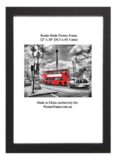A Brief Tour of Window Mats and Their Openings. In this blog we will try to shed some light on Window Mats  and Their Openings, with a particular focus to their external and internal sizing. A window mat ( Customers often call them edges, cardboards, surrounds, masks, etc ) or a window mount, as our English brethren would call one is that white or coloured cardboard that framers often put around images and inside picture frames. Broadly speaking, window mats are placed over and around images for several important reasons. The two main ones would be: a) the thickness of the mat ( around 1.2 or more millimetres) helps to keep the glass away from touching or rubbing the art and, b) the sides of the window mat distance the image, or art, from the frame, this facilitates a better perception and appreciation of the art away from the visual distraction of the adjacent wood frame.
and Their Openings, with a particular focus to their external and internal sizing. A window mat ( Customers often call them edges, cardboards, surrounds, masks, etc ) or a window mount, as our English brethren would call one is that white or coloured cardboard that framers often put around images and inside picture frames. Broadly speaking, window mats are placed over and around images for several important reasons. The two main ones would be: a) the thickness of the mat ( around 1.2 or more millimetres) helps to keep the glass away from touching or rubbing the art and, b) the sides of the window mat distance the image, or art, from the frame, this facilitates a better perception and appreciation of the art away from the visual distraction of the adjacent wood frame.
For a quick reference explaining the basics of a picture frame and its component please visit our page detailing the picture frames parts names. You probably won’t see a mat around a poster but you’ll often see one around a photo frame or picture frames that commemorates an important event, like a wedding, for instance. Window mats, or mats from now on, are a disparate component, almost invariably hand-made, precision cut and assembled by professional picture framers.
It is not to be confused with the white margins or borders photographic laboratories often include and print with images. Most window mats are cut from matboard sheets which are commercially produced for a price. A minority of matboard sold is of higher quality, such as archival, conservation or museum quality. The advantage, disadvantages, pros and cons of each will not be discussed here as it would be beyond the scope of this post, Window Mats and Their Openings.
Regardless of its quality however, when cutting mats from sheets, both external and internal sizes are important and need to be precise, and within a few millimetres, to be exact. Let us begin with the external, or the outside size of a mat. Picture framers generally measure the inside of an assembled frame and would cut the outside of the about 4 or 5 millimetres shorter. Thus if the inside of a frame measures 600x400mm, the externals size, or the outside of the mat, would be cut at 596x396mm.

The reason for the mat being cut slightly smaller than the inside of the frame is for clearance. Unless there’s a small clearance the mat would need to be forced or jammed inside the frame. Not only this is bad picture framing as it could buckle and ruin the mat, but such an interference fit would also prevent material expansion, and most likely leading to the mat bending or cockling, both unsightly and undesirable.
We now progress to cutting the inside of the mat. Some framers call this the “exact mat opening” others the “opening” or the ‘cutout” but we, along with most framers, will call it simply the “hole”, because, well, it is a hole cut into the matboard! The matboard hole goes over the photo or image as typified below:

As illustrated above, the matboard hole is always cut a little smaller than the art, and goes over it, overlapping it a little, on all sides. Window mat holes need to be slightly smaller than the art being matted, to cover the sides, otherwise the art might fall out.
If the art is, say, an A4 document, this being 210x297 mm, the hole should be cut a bit smaller, say, 204x293 mm. Most mass produced window mats will go over the art and cover a bit more, perhaps 5 to 6mm. Custom framing shops with professional bench mat cutters can cut ‘tighter’ mats with less overlap, even about 2 or 3mm but not too much more lest the art “pop out” of the hole.
Tighter mats enable Customers to view more details and more of the image since less art is covered, though we are only talking about millimetres. When a window mat features more than one hole, it is often called a “collage” or “photo mat collage” and the much the same, preceding information applies to these. In addition, holes need not be square or rectangular, circles and ovals can often be cut into mats with mat cutting tools called circle and oval cutters.
More rarely, window mats can be carved by hand with carving knives. These carvings can be astonishingly beautiful, from delicate flowers to exquisite arabesques, intricate silhouettes, and so on and so forth. This is a highly specialized skill and in Australia, at least we have only seen a handful of people practising this highly skilled, yet unappreciated, speciality.
With regard to normal window mats, Customers often ask us what are the right proportions, ideal ratios, or best widths for window mats, but we explain that this is really their choice, whether they would like small, medium, or large mats. However, and for those who may be interested, we have a web page discussing picture framing preferable proportions which the may visit. Taking the subject of desirable, or well-proportioned, picture framing sizes and proportions further, we also have a page discussing the fabled Picture Frame Golden Ratio.
And lastly, for those other who wish for a do-it-all, Magic Wizard to take away all the drudgery of picture framing, mounting and mat cutting calculations we have developed a a free, Picture Framing Work Calculator . By and large, all preceding information applies and pertains to the average custom picture framing order. Valuable, precious, expensive or irreplaceable art with sentimental, historical or financial significance should be at the very least archivally matted, mounted and frames or even better, with conservation quality or museum grade techniques.
The relative aspects of each of these framing methods are beyond the scope of this post and will not be discussed here but any professional picture framer should be able to help in these regards. For trade or business Customers who require, inexpensive, commercially-produced acid-free, production window mats at low prices and without any archival or conservation considerations we have Photo Mats, Window Mats and Matboards Sheets available. These imported, production mats are suitable for mechanical reproductions such as inexpensive, disposable, ephemeral or commercial posters which, typically, have little value to Customers and serve largely decorative purposes. Thank you for reading this post "Window Mats and Their Openings."









Very instructive post. In particular, I now know when, how and why window mats are made for picture frames. I’m an artist trying to save money when framing my work and the only way I can do this is to do as much of the picture framing myself. If I can mount and mat my art myself I can save more than half in my framing costs. Thank you.